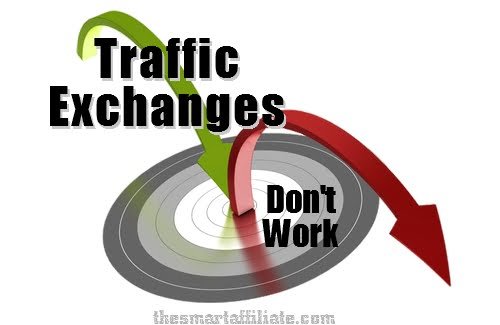It’s all about Traffic Exchanges
It’s another Traffic Tactics Thursday! Today, I’ll be covering yet another slightly controversial topic that some marketers still use. It’s especially targeted to those who are inexperienced or new. And it has no real value. Traffic Exchanges – Why you should avoid them!
There are a number of effective traffic methods for you to promote your site online. Unfortunately, there are also a number of highly questionable ways and are a total waste of time!
My aim is to focus on positive topics for my article posts. However the wild ride you get from traffic exchange “options” is something I feel a responsibility to warn you about.
Are Traffic Exchanges a good idea?
When you’re new with promoting your business online, you most likely are looking to find ways for “getting the word out there”. And with a low budget, often they are “free” methods.
After conducting enough searches online, You quickly discover that there are at least a million and one different sites all making incredible traffic generation claims and promising to deliver the world!
In the process, no doubt, you have most likely found a few of those methods have come from traffic exchanges. While most traffic exchanges don’t claim to make you an instant online sensation, they do claim that they can send you untold numbers of “hot targeted prospects”.
The Problem with their claims
I have a problem with that – because the quality of their traffic is almost always extremely poor. That is why traffic exchanges don’t work, and why you should avoid them.
The revelation of what they offer is in their name, but first I’ll give you a little history to help you understand the context in which traffic exchanges have come into existence.
Their Background
Back in the earlier days of the Internet, sometime before the new millennium, the first traffic exchange was born. It was a very sound concept and at the time worked very well.
You would sign-up and agree to view or “surf” other members’ sites or offers in exchange for other “like” members to view your site or offer.
The idea behind this was as you surfed, you would “earn” viewing credits that you could built up then use to display your offer or site across the network for other members to see as long as you had credits.
When this concept was new, it worked very well. It was a great and quick way to get traffic to your site or offer. Then as always, the business model was duplicated over and over becoming worse. There seemed to be a new traffic exchange starting out each week.
Competition became strong and exchanges had different offers for their surf-to-display ratios. And all the same people became members of all the same exchanges creating overkill.
The lure of massive free traffic
Now back to the present. With a little research effort, it doesn’t take long to discover that search engines still drive the majority of the web traffic on the Internet, with social media being a close second.
For those who use traffic exchanges today, the vast majority of them are brand new marketers who don’t know any better and those who think they are saving money because it’s a “free” method for promoting their website.
Sadly though, the reality is NO ONE who uses a traffic exchange is interested in what you have to sell. All they care about (just like you) is earning credits to get traffic to their own website.
This all adds up to nobody really seeing your page and equates to a very poor return on your efforts. It is a major waste of time, which is your most precious commodity! So much for “free”.
Another negative key factor for those of you who are using traffic exchanges is understanding that when a person is viewing your site, it is only for a very short period, usually about 5–20 seconds. The more people who view it from those exchanges will negatively influence the Bounce Rate.
Why is a high bounce rate an issue?
If a website or blog has a high bounce rate, then search engines will think that visitors are not interested in your content and this will affect your site rankings. The Bounce Rate is calculated by the average time a visitor stays on the site. With traffic exchanges, that’s not long at all.
Sadly, even though Traffic Exchanges can increase your site’s visit rate, they also will increase the bounce rate which will negatively impact your ranking on search engines.
Another issue is traffic exchanges rely on software to automatically distribute the traffic around the network. There’s always a good chance another piece of software is being used to cheat their system. These “bots” are available to buy if you look around.
When enough of these bots are in use, it will effectively make a traffic exchange completely useless and they regularly do. No matter how much “cheat security” an exchange owner puts into place, there is some savvy coder who can always find a way around it and they do.
Final Thoughts…
As you can see, I have given some very good reasons to warn you about using traffic exchanges and hopefully stop you from wasting your time. forget about using traffic exchanges altogether.
Instead, concentrate on developing other traffic methods that work. Refer to those I have already shared in article posts on this site. I encourage you to take a look at Traffic Tactics Thursday where those methods are described.
As always, please leave a comment, observation or question you may have below in the comment section. 🙂


It’s great to hear someone experienced like you, Michel, to give background info about the history of internet marketing.
And it’s also unsual and great to have advice about what you should NOT waste your time on. Most of the time you only hear: “Try this. Try that. Try that.”
Thanks Andrea,
It is important to me to share my experience with what works along with what doesn’t so that others can save money, time and energy! 🙂
Some interesting input about trafficexchanges here,thanks for sharing 🙂
Thank you for visiting!
Wow – I never knew about Traffic Exchanges…
I can see why they aren’t very popular right now since Google wants engagement and high quality content right now, which makes total sense.
Sad that people are trying to use this form of marketing
Dr. Lisa
Yes Lisa, it is sad that those who look to use this form of marketing are mainly newbies that want to save money and are duped in believing this is some sort of powerful way to gain traffic. Instead exchanges contain members who waste time promoting their offers to other members who are all doing the same thing (to gain more credits, not buy any products, except for services to get more credits from the exchange). I wanted to prevent others from falling for this method. 🙂
Hi Michel,
I have forgotten about Traffic Exchanges. I remember using one long time ago when I was a Newbie. You are completely right, these days they are completely outdated and there is absolutely no value in using them. It surprises me that they are still around.
Thanks Dita,
Unfortunately they are still active and a tempting trap for newbies…